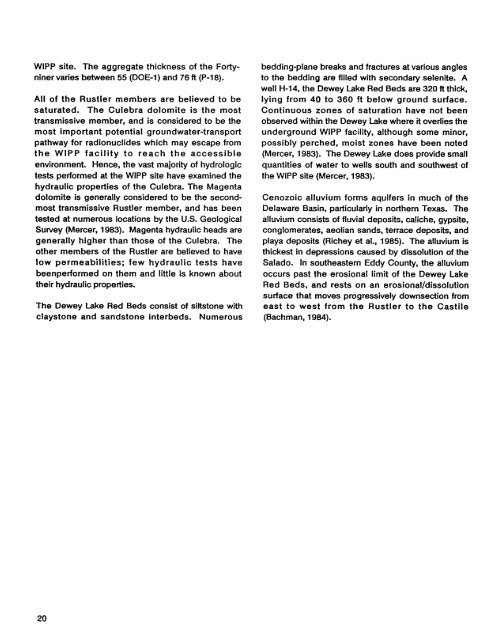Beauheim 1987 - Waste Isolation Pilot Plant - U.S. Department of ...
Beauheim 1987 - Waste Isolation Pilot Plant - U.S. Department of ...
Beauheim 1987 - Waste Isolation Pilot Plant - U.S. Department of ...
Create successful ePaper yourself
Turn your PDF publications into a flip-book with our unique Google optimized e-Paper software.
WlPP site. The aggregate thickness <strong>of</strong> the Fortyniner<br />
varies between 55 (DOE-1) and 76 ft (P-18).<br />
All <strong>of</strong> the Rustler members are believed to be<br />
saturated. The Culebra dolomite is the most<br />
transmissive member, and is considered to be the<br />
most important potential groundwater-transport<br />
pathway for radionuclides which may escape from<br />
the WlPP facility to reach the accessible<br />
environment. Hence, the vast majority <strong>of</strong> hydrologic<br />
tests performed at the WlPP site have examined the<br />
hydraulic properties <strong>of</strong> the Culebra. The Magenta<br />
dolomite is generally considered to be the secondmost<br />
transmissive Rustler member, and has been<br />
tested at numerous locations by the US. Geological<br />
Survey (Mercer, 1983). Magenta hydraulic heads are<br />
generally higher than those <strong>of</strong> the Culebra. The<br />
other members <strong>of</strong> the Rustler are believed to have<br />
low permeabilities; few hydraulic tests have<br />
beenperformed on them and little is known about<br />
their hydraulic properties.<br />
The Dewey Lake Red Beds consist <strong>of</strong> siltstone with<br />
claystone and sandstone interbeds. Numerous<br />
bedding-plane breaks and fractures at various angles<br />
to the bedding are filled with secondary selenite. A<br />
well H-14, the Dewey Lake Red Beds are 320 ft thick,<br />
lying from 40 to 360 ft below ground surface.<br />
Continuous zones <strong>of</strong> saturation have not been<br />
observed within the Dewey Lake where it overlies the<br />
underground WlPP facility, although some minor,<br />
possibly perched, moist zones have been noted<br />
(Mercer, 1983). The Dewey Lake does provide small<br />
quantities <strong>of</strong> water to wells south and southwest <strong>of</strong><br />
the WlPP site (Mercer, 1983).<br />
Cenozoic alluvium forms aquifers in much <strong>of</strong> the<br />
Delaware Basin, particularly in northern Texas. The<br />
alluvium consists <strong>of</strong> fluvial deposits, caliche, gypsite,<br />
conglomerates, aeolian sands, terrace deposits, and<br />
playa deposits (Richey et al., 1985). The alluvium is<br />
thickest in depressions caused by dissolution <strong>of</strong> the<br />
Salado. In southeastern Eddy County, the alluvium<br />
occurs past the erosional limit <strong>of</strong> the Dewey Lake<br />
Red Beds, and rests on an erosional/dissolution<br />
surface that moves progressively downsection from<br />
east to west from the Rustler to the Castile<br />
(Bachman, 1984).<br />
20

















